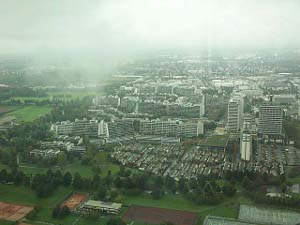 Olympic Village from tower
Olympic Village from tower
Munich is the third largest city in Germany and it feels like it. From the moment we left the train, on Track 27 of the station, we found ourselves surrounded by men, women, children walking, children in strollers, signs, shops, luggage carts, vendors, dogs and backpacks. And that was just the platform.
 Olympic Village from tower
Olympic Village from tower
The station is all steel and glass and neon. Trains from the modest-looking locals to the super-modern Inter-City Expresses move in and out smoothly and silently. We made reservations for our high-speed trip to Hamburg next week, and checked schedules for some possible excursions.
Our taxi driver, a middle-aged woman, is diligently learning English (partly because her brother-in-law, an American, keeps putting off learning German; she'll show him!); she keeps study materials in her car and is taking a class, because, she says, there are more and more English-speaking tourists in Munich. Certainly more Munichers speak and understand English, a notable contrast from the almost universally monolingual German city of Regensburg.
The next morning it was colder and rainier than yesterday, so we took the bus tour. It turned out to be a fine idea; our guide was experienced and pleasant. Munich actually has fewer ancient buildings than Regensburg, because Munich is a newer city and suffered more damage in WW II. We were able to get a good idea of the major sights in an hour and then went to the 1972 Olympic Park. Designed by Guenther Behnisch, Frei Otto and Partners, the Olympic buildings are still beautiful, large tentlike structures, with translucent roofs. The entire Park area was a huge mound of rubble created as the city rebuilt; so they piled on dirt, planted trees, dug a lake, and transformed it into a beautiful glade.
 BMW HQ from Olympic Tower
BMW HQ from Olympic Tower
Our tour included a ride to the top of the Olympic Tower. On a clear day the views would be spectacular, taking in much of the surrounding countryside including the Bavarian Alps. As it was, we were still able to see much of the city and get a good orientation for our sightseeing this week. The view of the dormitories at Olympic Village was, unfortunately, familiar from the TV scenes of the attack against Israeli athletes by Palestinian terrorists. The buildings are now condominiums.
In Munich the railway tracks run from the Hauptbahnhof to the Ostbahnhof, and a number of commuter trains go from one side of the city to one railroad station, then to the other railroad station, and out to the other side of the city. These are the S-Bahn, which use the state-owned railway lines. Then all the underground trains, or U-Bahn, connect to the S-Bahn system between the two railway stations. So a typical tourist ride is hotel to downtown by U-Bahn, change to S-Bahn, ride a stop or to, change to another U-Bahn. Of course there's also streetcars and buses, and we hastened to get a map of the whole system. What amazes us (after seeing the mighty efforts and investment of political capital required to get a basic rail transit system going in Los Angeles) is that the entire Munich underground was built after WW II (in fact since the 1960s).